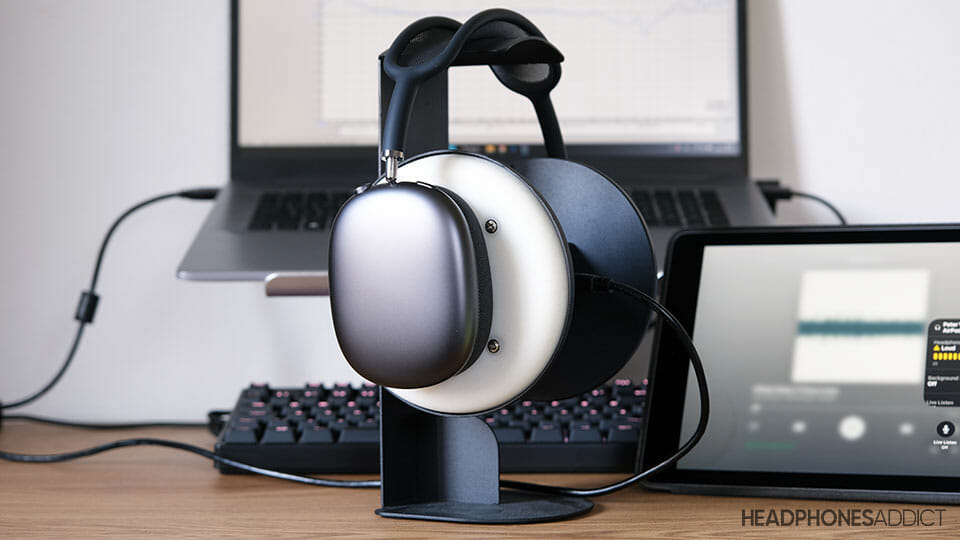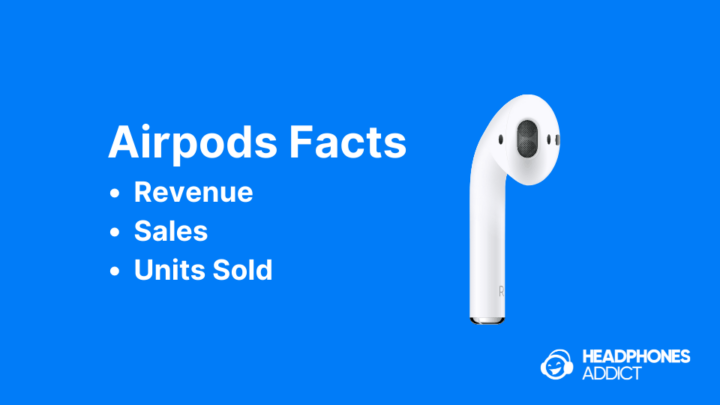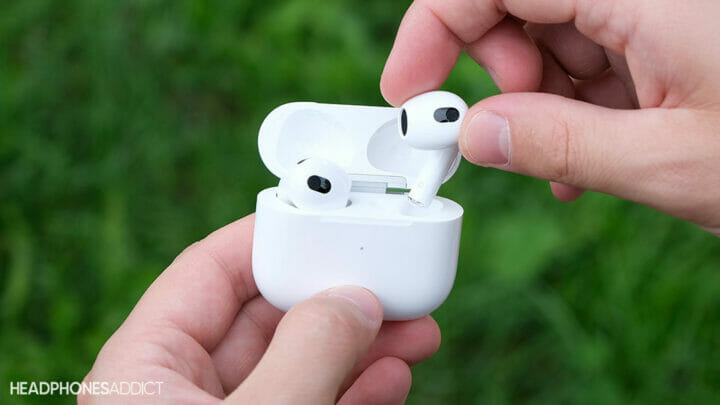More and more people have headphone-induced hearing loss. So we decided to test the loudness of the most popular headphones on the market: Apple AirPods.
We tested AirPods 3 and AirPods Max. This is what we found out.

We discovered that AirPods play slightly quieter on iOS devices and that Apple AirPods 3 are louder than Apple AirPods Max during real-world use.
Furthermore, the Headphone Audio Level feature in iOS tends to exaggerate the actual loudness of your AirPods.
So, are AirPods safe to use? The full results are much more fascinating. More on that below.
Apple AirPods 3
Based on results from our first test using white noise, Apple AirPods 3 reach the loudness of 105.7dB at 100% volume.
The recommended exposure time at that loudness is less than 4 continuous minutes. You can learn more information about safe headphone volume in our separate article.
Furthermore, they have a consistently lower loudness than AirPods Max at the same volume level. On average, AirPods 3 are around 4.4 dB lower.
Here are the AirPods 3 loudness results and how long you can listen to them at different volumes:
| Loudness percentage | Apple AirPods 3 | Recommended listening time (before causing hearing damage) |
|---|---|---|
| 100% | 105.7dB | 3min 45sec |
| 90% | 100.8dB | 11min 54sec |
| 80% | 95.5dB | 37min |
| 70% | 89.8dB | 2h 38min |
| 60% | 83.5dB | 10h |
| 50% | 77.5dB | More than 25h |
| 40% | 70.6dB | / |
| 30% | 63.3dB | / |
| 20% | 54.6dB | / |
| 10% | 44.9dB | / |
However, the second test with music, representing real-world usage, is where things get mesmerizing.
Apple AirPods 3 become louder than AirPods Max by an average of 4.7 dB. We repeated the test twice and got similar results.
Here are the results from our second “real-world” test, with AirPods 3 playing at 100% volume.
| Results | Apple AirPods 3 | Recommended listening time (before causing hearing damage) |
|---|---|---|
| Song test (IPAD) | 91.9dB | 1h 35min |
| White noise track (IPAD) | 83.4dB | 12h |
| Song test (SAMSUNG PHONE) | 95.8dB | 38min |
| White noise track (SAMSUNG PHONE) | 84.1dB | 10h |
| Song test (HP LAPTOP) | 96.1dB | 37min |
| White noise track (HP LAPTOP) | 84.2dB | 10h |
Why is the max volume lower?
Read our possible explanation as to why that happened under the discussion below.
Apple AirPods Max
Based on our white noise measurements for the first test, Apple AirPods Max are the loudest AirPods, reaching 108.3dB at 100%.
That means that listening to anything at 100% volume for more than 2 minutes can result in hearing damage.
Moreover, the first test also shows that AirPods Max appear louder than AirPods 3.
Here are the AirPods Max loudness results and how long you can listen to them at different volumes:
| Loudness percentage | Apple AirPods Max | Recommended listening time (before causing hearing damage) |
|---|---|---|
| 100% | 108.3dB | 2min 10sec |
| 90% | 104.4dB | 5min |
| 80% | 99.8dB | 15min |
| 70% | 94.1dB | 1h |
| 60% | 88.3dB | 3h 50min |
| 50% | 82.3dB | Less than 16h |
| 40% | 75.5dB | More than 25h |
| 30% | 68.2dB | / |
| 20% | 59.4dB | / |
| 10% | 49.8dB | / |
Interestingly, in our second test with music showing real-world usage, AirPods Max are actually quieter than AirPods 3 by roughly 4.7 dB.
Here are the results from our music test using Apple AirPods Max at 100% volume:
| Results | Apple AirPods Max | Recommended listening time (before causing hearing damage) |
|---|---|---|
| Song test (IPAD) | 83.4dB | Less than 12h |
| White noise track (IPAD) | 81.5dB | Around 16h |
| Song test (SAMSUNG PHONE) | 88.7dB | Less than 4h |
| White noise track (SAMSUNG PHONE) | 82.3dB | Less than 16h |
| Song test (HP LAPTOP) | 88.6dB | Less than 4h |
| White noise track (HP LAPTOP) | 82.5dB | Less than 16h |
How does the Airpods Max and AirPods 3 loudness compare?
Here is the comparison table showing the results from our first white noise test between Apple AirPods 3 and AirPods Max:
| Loudness percentage | Apple AirPods Max | Apple AirPods 3 | Difference |
|---|---|---|---|
| 100% | 108.3dB | 105.7dB | 2.6dB |
| 90% | 104.4dB | 100.8dB | 3.6dB |
| 80% | 99.8dB | 95.5dB | 4.3dB |
| 70% | 94.1dB | 89.8dB | 4.3dB |
| 60% | 88.3dB | 83.5dB | 4.8dB |
| 50% | 82.3dB | 77.5dB | 4.8dB |
| 40% | 75.5dB | 70.6dB | 4.9dB |
| 30% | 68.2dB | 63.3dB | 4.9dB |
| 20% | 59.4dB | 54.6dB | 4.8dB |
| 10% | 49.8dB | 44.9dB | 4.9dB |
And here is the comparison table showing the results from our second test at 100% volume with music between Apple AirPods 3 and AirPods Max:
| Results | Apple AirPods Max | Apple AirPods 3 | Difference |
|---|---|---|---|
| Song test (IPAD) | 83.4dB | 91.9dB | 8.5dB |
| White noise track (IPAD) | 81.5dB | 83.4dB | 1.9dB |
| Song test (SAMSUNG PHONE) | 88.7dB | 95.8dB | 7.1dB |
| White noise track (SAMSUNG PHONE) | 82.3dB | 84.1dB | 1.8dB |
| Song test (HP LAPTOP) | 88.6dB | 96.1dB | 7.5dB |
| White noise track (HP LAPTOP) | 82.5dB | 84.2dB | 1.7dB |
Related:
Discussion About Results
Loudness anomaly between the first and second test
By comparing the frequency spectrum of REW-generated white noise and the white noise from Spotify, you can see that Spotify’s noise is much more bass focused.

The graph shows that the difference between AirPods 3 and Max is much more significant in higher frequencies on Spotify white noise than on REW’s white noise.
That could be one of the logical reasons Apple AirPods 3 appear louder: they simply boost higher frequencies more than AirPods Max.
In contrast, REW’s white noise has a more even spectrum. So the louder sub-bass might have played a role in why REW’s noise appears louder on AirPods Max.
Related:
Sound from iPad is quieter than Android & PC
On average, AirPods play 2.7dB quieter when using iPad compared to an Android smartphone or a Windows laptop.
The table shows the difference in loudness between iPad and an Android smartphone during our tests:
| Loudness from iPad | Loudness from Android | How much is iPad quieter | |
|---|---|---|---|
| Song test (AirPods Max) | 83.4dB | 88.7dB | -5.3dB |
| Song test (AirPods 3) | 91.9dB | 95.8dB | -3.9dB |
| White noise track (AirPods Max) | 81.5dB | 82.3dB | -0.8dB |
| White noise track (AirPods 3) | 83.4dB | 84.1dB | -0.7dB |
We tested AirPods in Bluetooth mode to exclude bias by using a wired connection (which is possible in AirPods Max). Meaning that only the hardware built into AirPods can influence their sound.
However, our article about Bluetooth codecs mentions that different devices encode/decode Bluetooth codecs more efficiently than others.
Apple is known to have superior AAC processing quality and efficiency. However, it’s possible that their processing orders headphones to play audio at a different loudness. Or it could be a translation anomaly from OGG (the audio format used by Spotify) to AAC.
Is iOS Headphone Audio Level Showing Correct Loudness?
On average, the loudness displayed by Apple’s Headphone Audio Level feature in iOS was 6.9 dB higher than the loudness measured on our MiniDSP.
Here are the loudness results at 100% volume measured by our MiniDSP H.E.A.R.S and iOS:
| Measuring tool | Apple AirPods 3 | Apple AirPods Max |
|---|---|---|
| MiniDSP (White noise) | 84.2dB | 82.5dB |
| iOS HAP (White noise) | 91dB | 87dB |
| MiniDSP (Song) | 96.1dB | 88.6dB |
| iOS HAP (Song) | 98dB | 92dB |
Apple implemented the feature in iOS 14, which shows how loud your headphones’ audio is in real-time.
You can find it in Control Centre. Otherwise, you have to add it:
- Go into “Settings.”
- Find “Control Centre” and tap on it.
- Add “Hearing” in INCLUDED CONTROLS by tapping “+.”

Remember that the feature only works with Apple headphones (not tested for Beats headphones).
It uses a microphone built inside the AirPods that is normally responsible for the AdaptiveEQ feature (continuously tweaking the EQ so that the listener always hears the sound as Apple intended).

But why is it inaccurate?
That’s probably due to the mic’s placement right in front of the driver, meaning it gets full-blown sound directed at it.

However, the sound loses intensity with distance and when hitting obstacles (your pinna, ear canal). So when it reaches your eardrums, the loudness has already dropped a little.
Nonetheless, the feature is still very useful in letting people know they’re listening to music too loud. Hopefully, more people will decide to lower the volume and protect their hearing.
How We Made Our Tests
Initially, we calibrated our MiniDSP H.E.A.R.S to show the accurate loudness values.
First test
We connected AirPods to our Windows laptop via Bluetooth and made our first test by using “Noise Generator” and “SPL Meter” tools inside the REW (Room Equalizer Wizard) software.
We then measured the AirPods’ loudness from 100% to 10% volume, each time lowering the volume by 10%.
Second test
We made this test to represent real-world usage better.
We used 3 different devices:
- iPad (running iPadOS 15)
- Samsung Galaxy S21 (running Android 13)
- HP laptop (running Windows 11)
For consistency, we decided to use Spotify as our only audio source.
For the song test, we picked:
- Intro from “Friend or Foe? (Album Version)” by Riverside (between 0:49 and 0:56)
- “White Noise 3 Hour Long” by Erik Eriksson
We then placed AirPods on our MiniDSP and left them there until all tests were complete. Switching between all 3 devices, we observed the loudness at 100%.
Conclusion
Our in-depth testing showed that AirPods Max and AirPods 3 are much quieter in real-world situations, even though they can get dangerously loud in controlled tests.
Also, we learned how much a sound signature and even Bluetooth codec encoding/decoding can affect the end loudness.
Despite the differences between the two AirPods, both are more than loud enough for daily use. Our measurements show that AirPods 3 will cause hearing damage after just 40 minutes of music listening at 100% volume.
Therefore, remember to keep the volume down and protect your hearing.

From a childhood fascination with sound, Peter’s passion has evolved into a relentless pursuit of the finest headphones. He’s an audio expert with over 5 years of experience in testing both audiophile and consumer-grade headphones. Quote: “After many years, I can confidently tell which headphones are good and which are terrible.” Find his honest opinion in his reviews.



